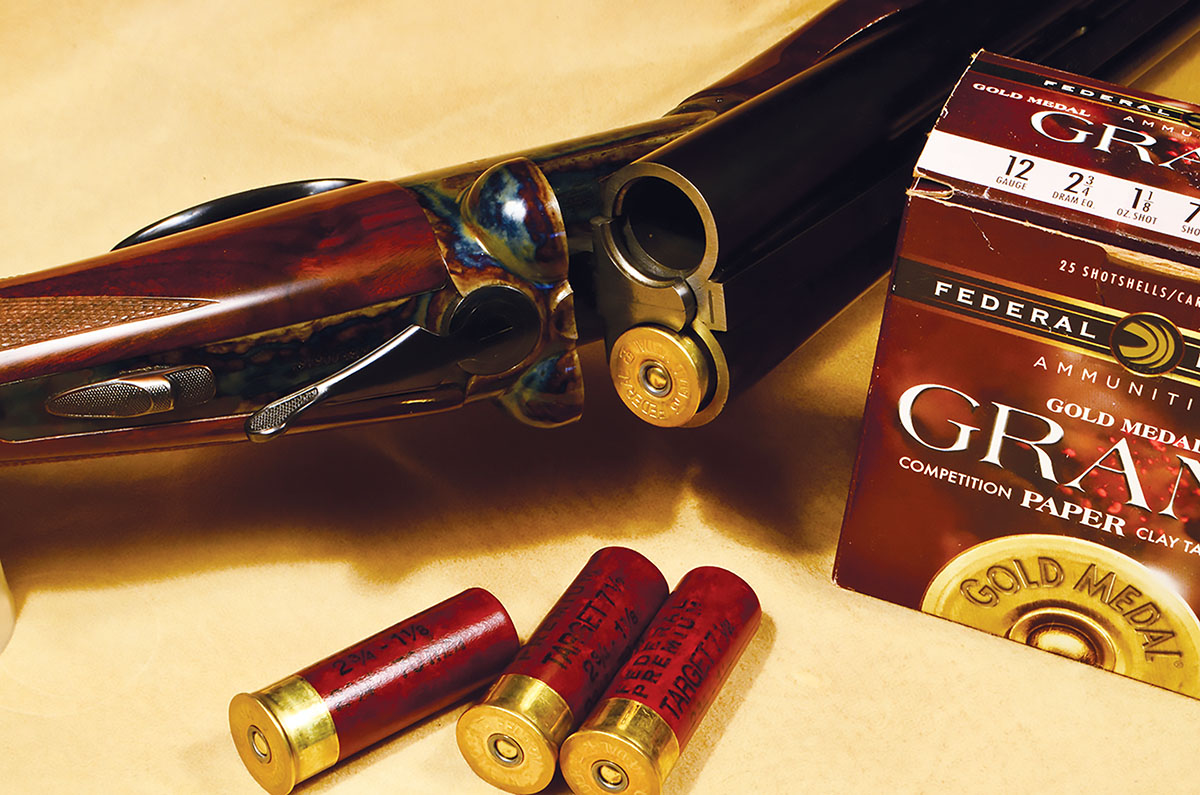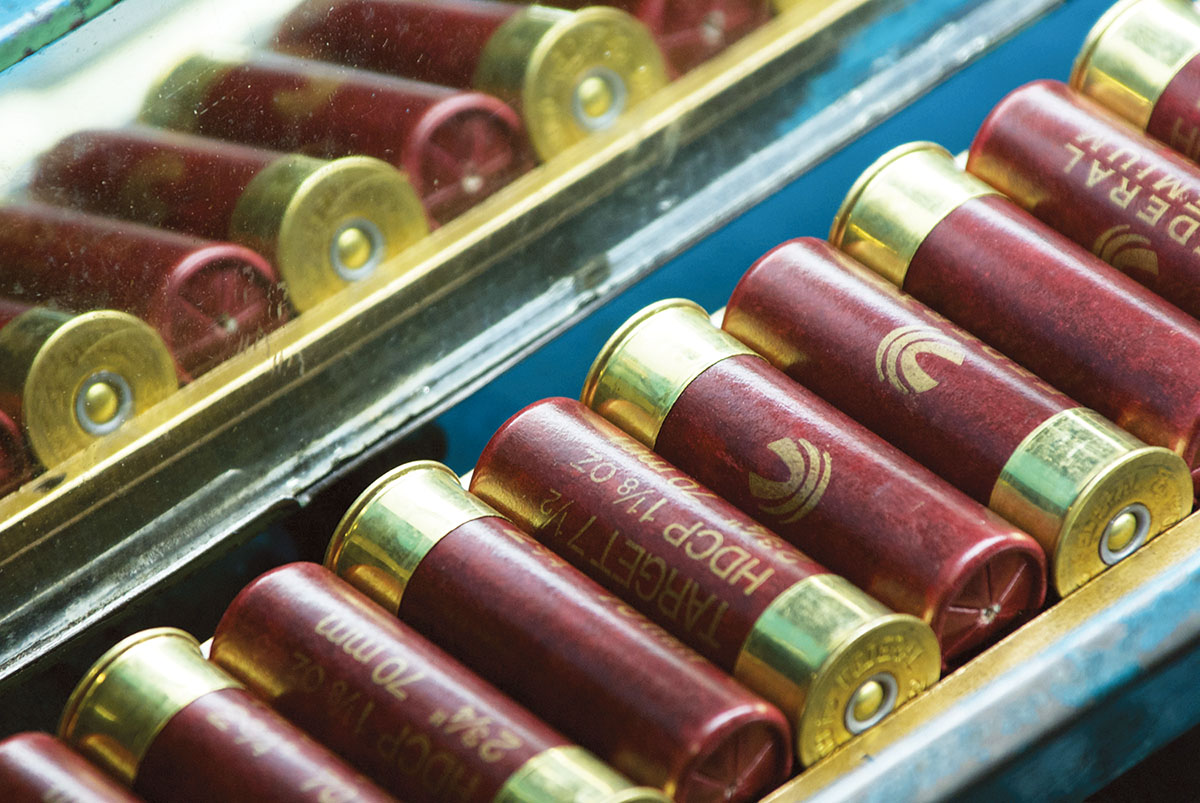In Range
One More Good Reason
column By: Terry Wieland | August, 24

A few years ago, I experienced what was then known as a Transient Ischemic Episode (TIE), now called an Attack (TIA), presumably to make it more dramatic. A TIE strikes suddenly, with some of the symptoms of a full-blown stroke, but usually passes in a few minutes.
Still, it landed me in the hands of a neurosurgeon who prescribed some medication – one was a pill to thin the blood, the other to combat mild high blood pressure – and I took these faithfully every day for the next couple of years. There were no adverse side effects except for a tendency, if I cut myself, to bleed, and bleed and…bleed.
This was no big deal until I found myself in the midst of a two-day shotgun match where I was using a relatively light gun (7.5 pounds) with RST cartridges, which combine 1¼ ounces of shot with a 3¼ dram-equivalent powder charge – the famous “pigeon load” of a century ago. In this pigeon-simulation match, you load two rounds and if you miss the first shot, follow up immediately with the second. The buttstock is often out of position for the second shot and gives a wicked kick. Since most fire both shots more often than just one, the pounding adds up.
I felt my shoulder getting sore but soldiered on. At the end of day one, my right arm was bruised from shoulder to wrist and completely around the arm, combined with swelling that limited how far I could bend or lift it. Lovely.
For day two, I switched to a heavier gun and lighter loads, and that minimized further damage, but left me bruised to the palm of my hand and with severely limited arm movement for the next three weeks as the bruising and swelling slowly subsided.
This led to a rather careful study of the relative effectiveness of various shotshell loads. I was not about to give up shooting, but equally did not want to repeat that bruising experience.
The following year, I used the same gun (Purdey hammer gun, circa 1881) and Remington handicap trap loads (11⁄8 ounce) and while the bruising was not as bad, it was certainly noticeable. Since I’d discontinued the blood thinner six months earlier, that was no longer a contributing factor. For day two of the match, however, I was still not happy, I switched to my W&C Scott & Son, which weighs 8.5 pounds. Unlike the Purdey, it does not have a recoil pad, but I figured the extra pound would more than make up for that, and the damage was reduced still further.
Now we come to this year. Again, I shot my Scott, but changed to Federal Gold Medal Paper handicap trap loads (11⁄8 ounce, 1,200 feet per second). The result? No pain and not a trace of a bruise. I mean, none!
Ballistically, the Federal Paper has slightly lower velocity than the Remington (1,200 fps vs 1,235), which makes no difference to the target if I hit it. But it certainly made a difference to my shoulder, both in the felt recoil while shooting, and the complete absence of bruising later.
Federal Gold Medal Paper has been an object of almost iconic reverence for trapshooters for a century. While every other major manufacturer dropped paper shotshells in favor of plastic for a variety of production, economic, and alleged ballistic reasons, Federal swam against the tide and kept its in production. When I went to Anoka, Minnesota, a few years ago and toured the paper-shotshell production facility, their explanation was simple: Trapshooters would simply not let them discontinue their prized product.
Why? What’s so special?
One reason given by trapshooters themselves is that they deliver better performance – they break more birds – and that the recoil is less. To a trapshooter, minimal recoil results in less flinching, which can become the bane of a trapshooter’s life. Though trap loads are noted for being powder puffs compared to even standard field loads, the effect is cumulative, and a shooter might fire 250 to 300 rounds a day in a trap match and twice that in a week of practice. These ills are not products of their fevered imaginations.

All of that was in the past, however, as I searched for answers on recoil. So this year, as I mentioned, I shot the entire two-day match with nothing but Federal Gold Medal Paper handicap trap loads, and had no bruising or pain whatsoever.
A few years ago, there was a slight but discernible trend toward offering lighter loads in shotshells, largely influenced by Michael McIntosh, Nick Sisley and a few other writers, but it was short-lived and now we seem to be back to manufacturers pursuing a bigger market share by pushing ever more powerful (and painful) shotshell loads.
This means that those of us who like to enjoy shooting, rather than simply endure it, need to load our own.
At this point, I should add that the price of Federal paper, as per its website, is now $20.99 a box, or uncomfortably close to a buck a shell. Their plastic-hulled elite match ammunition, High Over All, is $16.95 – a big difference over the course of a season.
Personally, I have never had very good results attempting to reload Federal paper hulls with their pie crimp. It is tricky compared to mass-producing trap and skeet loads with plastic hulls, and it slows down production considerably. But, given the events of the past couple of years, I think it now may be time to get into it seriously and learn the technique.
For a while there, shotshell prices, especially those made for mass sale to gun clubs and diehard trap and skeet shooters, had dropped so far that it was hard for a handloader to compete, economically. At one point, when the Canadian dollar was at an all-time low, shotshells imported from Canada – and very good stuff indeed – were selling for less than five bucks a box, and I could usually find a flat for $45.
Those days are gone. Federal’s Top Gun economy load lists on its website at $12.99 a box. Remington Gun Club is the same, while the Winchester loads I buy at my trap club are more than a hundred dollars a flat at members’ price.
But money is only one consideration, and as we get older, weaker, more prone to injury, or just in search of more comfortable loads, reloading shotshells can become the only game in town.
Since time immemorial, lovers of the 16 gauge have had to load their own if they want anything approaching what I would call a civilized load. What few options are available all seem to reflect manufacturers’ desire to prove they can pack enough into a 16-gauge shell to equal a 12, which is not what 16-gauge devotees want. I should mention that RST is the exception to that rule, and even offers paper-hulled 21⁄2-inch 16, but it’s expensive and hard to get. So, again…
In the 1990s, Michael McIntosh published data for powder-puff loads, but given the changes in components, such load data for shotshells in seldom very useful. Fortunately, Hodgdon has light loads listed on its website, and the of Ballistic Products’ Advantages Manual Shotshell Load Encyclopedia 11th Edition has a wide selection as well.
Having rolled my own in the past for financial, rarity, and performance reasons, I can now add self-preservation to the list – which seems eminently sensible.


